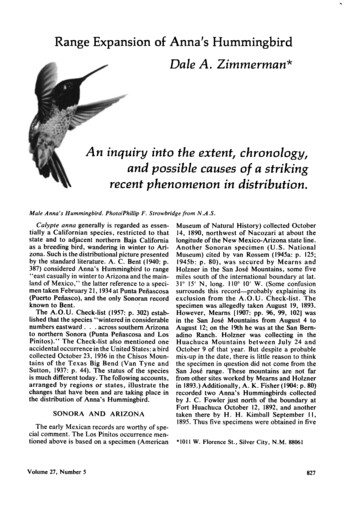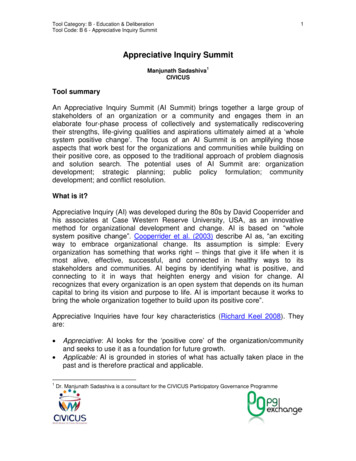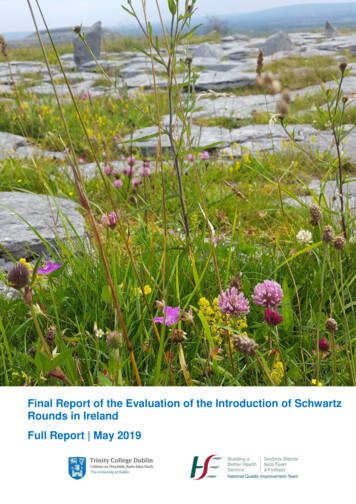
Transcription
Range Expansionof Anna's HummingbirdDale A. Zimmerman*An inquiry into the extent,chronology,and possiblecausesof a strikingrecentphenomenon in distribution.Male/lnna'sHummingbird. Photo/Phillip F. Strowbrldgefrom N.,q .S.Calypte anna generally is regarded as essen- Museum of Natural History) collected Octobertially a Californian species, restricted to that 14, 1890, northwest of Nacozari at about thestate and to adjacentnorthernBaja California longitudeof the New Mexico-Arizona state line.as a breedingbird, wanderingin winter to Ari- Another Sonoran specimen (U.S. Nationalzona. Suchis the distributionalpicturepresented Museum) cited by van Rossem (1945a: p. 125;by the standardliterature. A. C. Bent (1940: p. 1945b: p. 80), was secured by Mearns and387) consideredAnna's Hummingbirdto range Holzner in the San Jos6 Mountains, some five"east casually in winter to Arizona and the main-miles south of the international boundary at lat.landof Mexico," the latter referenceto a speci- 31ø 15' N, long. ll0 ø 10' W. (Some confusionmen taken February 21, 1934at Punta Pefiascosa surrounds this record--probably explaining its(Puerto Pefiasco),and the only Sonoranrecord exclusionknown to Bent.The A.O.U. Check-list(1957:p. 302) establishedthat the species"wintered in considerablenumbers eastward.across southern Arizonato northern Sonora (Punta Pefiascosaand LosPinitos)." The Check-list also mentioned oneaccidental occurrence in the United States: a birdcollected October 23, 1936 in the Chisos Moun-tains of the Texas Big Bend (Van Tyne andSutton, 1937:p. 44). The statusof the speciesis muchdifferenttoday.The followingaccounts,arranged by regions or states, illustrate thechangesthat have been and are taking place inthe distributionof Anna's Hummingbird.fromthe A.O.U.Check-list.Thespecimen was allegedly taken August 19, 1893.However, Mearns [1907: pp. 96, 99, 102] wasin the San Jos6 Mountains from August 4 toAugust 12; on the 19th he was at the San Bernadino Ranch. Holzner was collecting in theHuachuca Mountains between July 24 andOctober 9 of that year. But despite a probablemix-up in the date, there is little reason to thinkthe specimenin question did not come from theSan Jos6 range. These mountains are not farfrom other sites worked by Mearns and Holznerin 1893.)Additionally, A. K. Fisher 0904: p. 80)recorded two Anna's Hummingbirds collectedby J. C. Fowler just north of the boundary atFort Huachuca October 12, 1892, and anotherSONORAANDARIZONAThe early Mexicanrecordsare worthyof spe-taken there by H. H. Kimball September II,1895. Thus five specimenswere obtained in fivecial comment. The Los Pinitos occurrence men-tionedaboveis basedon a specimen(American *1011W. Florence St., Silver City, N.M. 88061Volume 27, Number 5827
years from a region of--at that time--precious much longer in southern Arizona, and at leasthttle ornithological activity. Perhaps Calypte some did not return to California to nest. Thefrequency,anna was not merely "casual" in southeastern specieswasreportedwith increasingArizona and northeastern Sonora in the 1890s. largely from suburban locales, by variousOutside of California the specieswas given observers. In a Phoenix residential area, anscant attention until van Rossem (1945b) dis- Anna's Hummer began building a nest in midcussed its eastern distributional limits. He November 1964;two younghatchedJanuary 12,stressedthat Willett as long ago as 1915found 1965, and these fledged February 8 (Mary LC anna "plentiful"from Nov. 30 to Feb. 3 at Bonnewell in Snider, 1965:p. 407). Through theRoosevelt Lake east of Phoenix. Loye Miller kindness of Gale Monson I have been able toand van Rossemalso found it "common and reg- examine the late Mrs. Bonnewell's originalularlydistributedin theEmoryoakbelt" of the detailed report of this nesting (and of certainPajafitoMountainswestof Nogales,October other hummingbird records discussedbeyond)At Nogales,SantaCruz County, Bill Harrison6-14, 1944.Dr. Miller and W. J. Sheffierhadfound it rare there in February 1941. Van Ros- noted the species until mid4anuary in 1966sem's1945paperlistedall occurrenceseastof (Snider, 1966: p. 447). That fall, the first preCalifornia known to him: 10 from Arizona and sumedmigrantsappearedin Tucsonon the ratherearlydateof September19(F. Tainter in Snider,AllanPhillips(1947)reviewedthebird'sstatics 1967: p. 65).three from Sonora.At least two pairs nestedin Phoenix in 1968betweenSeptember4 andJanuary8. (Someques- Una E. Miller noted two young in a nest Febtionable ones extended to January 21). He ruary 20 (andoneof thesefledgedsix dayslater)emphasizedthat in a seasonalsense,Calypte Ellis Jones found another nest January 15 andin southern Arizona, listing numerous recordsanna was not a true winter resident in that region.watched it until the young left February 8. HeAt Tucson,the species"provedto be a regular continued to see Anna's Hummingbirds in thevisitor in fall" between 1938 (when Phillips'area until February 25. Mrs. Miller observedrecordkeepingbegan)and1945,in whichperiod thosein her area almostdaily until March. Theseit occurred "regularly."records were mentioned without detail by SniderIn subsequentyears, the few recordssuggest (1968b: p. 466).that thebirdshadbegunto extendtheirfall visitaAt the Boyce-Thompson Arboretum neartion period. During the winter of 1949-50,the Superior, Pinal County, S. M. Russelland Dlast Anna was seen at Tucson January 23 by Lamm (not F. Tainter as reported in Snider,H Mowat (Monson, 1950:p. 215). Mary Jane loe. eit.) found a nest with two young among exNichols observed a male in the Santa Catalinaotic plantingsFebruary 20, 1968. Dr. Russellfoothills near that city February 12, 1954 informs me ers. comm.) that he saw "several(Monson, 1954:p. 263). Only three recordsfrom other Anna's (including singing males) in theArizona appearedin the pagesof AudubonField area" at the time.Notes between 1950and 1962;this does not meanSalomeR.Demaree'srecordsfromthethat the birds had become scarce, but that theirPhoenix area showeda "new high" of 31 Anna'sobserved occurrences were within what was conHummingbirds on the 1969-70 Christmas Birdsideredtheir period of usualvisitationto Ari- Count, reflectingthe "many" individualswinterzona. By the time of publication of the most ing there that year. Mrs. Demaree recorded eggsrecent Arizona check-list,Monson and Phillips hatching in a nest in ScottsdaleJanuary 7, 1970,(1964:p. 30) couldonly add that thesehumming- another nest under constructionJanuary 31, andbirds remained in southern Arizona"untila third found (in Phoenix) March 17. MrsDecember and rarely to early March." Phillips Demaree also found the species nesting inet al. (1964:p. 63)discussedthesituationin some- Phoenix between April 6 and May 4, 1971what more detail. By the mid-1960s there still(Snider, 1971a:p. 782).M. V. Mowbray reported at least one Anna'sHummingbird in the Hualpai Mountains nearno summeroccurrences.There was no positive Kingman in northwestern Arizona May 23, 1971record of breeding in the state, although a nest (Charles S. Lawson, pers. comm.). The specieswith young Monson observedin Yuma, March may occur there with some frequency but the15, 1962, "may have been Anna's" (Phillips et region is not well known ornithologically.al , Ioc. tit.).Summer records of this hummingbird inwere no Arizona records east of the Huachucas,Fort Grant, and Roosevelt Lake, and there wereSeasonalreportsin AudubonField Notespublished after 1964 reveal definite changesoccurring. Anna's Hummingbirds began to remain828ArizonaarescarceandallarerecentNoteworthy is Edgar Read's photograph(on file,Univ. Ariz.) of a male made on July 13, 1971American Birds, October 1973
This bird had been visiting Mr Read's Tucsonyard since July 5. Janet Witzeman reported afemale lingering in Phoenix until July 19, 1972A quarter of a century ago Phllhps (1947 p112)believed "the bulk of the Anna Hummingbirdsof southernArizona"to returntn(Mortson, 1972b:p. 889). Robert F. Miller (pers.comm.) closelyand repeatedly observedan adultmale in Cave Creek Canyon in the ChiricahuaMountains July 15, 1972--possibly the samebirdDecember to their breeding grounds nCalifornia. Perhaps most of them still do, butit is clear that an increasing number remains toseen at the AmericanResearch Station's feeders May 23 that year (C.S Lawson, pers. comm.). I saw a female Anna'sHummingbird at a feeder in Tucson June 19 andFrom southof the internationalboundarytherehave been only sporadic reports, but Sonoranoccurrencesnow are commonplace. By 1948, thespecies was described as "common" in late20, 1973.OctoberMuseum'sSouthwesternnest in Arizona.andNovemberintheCaborca-During February 1972, T. Parker et al. Imuris-Sonoyta region (Phillips and Amadon,observeda singingmale Anna's Hummingbird 1952:p. 164).Numberswere seenandfour specim Molino Basin in the Santa Catalina Mountains.mens were collectedbetweenOctober31 andHe and Linwood Smith found a nest with eggs November 3. Extending the known range stillm SabinoCanyonof the samemountainrange farther south, althoughhe provides no specfficFebruary 12 (Mortson,1972a:p. 640). A male records, Alden (1969: pp. 13, 15) indicatesthatseenby MortsonDecember 20 that year in the Anna's Hummingbirdsnow are commonduringlive oak belt (elev. 3760 feet) of Sabino Basin winter in the Magdalena Valley between Imunsmay havebeena winteringbird. The mostrecent and Magdalena, replacing the summer residentbreeding record known to me is that of a nest Black-chinned and Broad-billed hummingbirdsfound by Harold Fetter et al. in a Tucson ceme-(Archilochus alexandri and Cynanthus latiros-tery, February12, 1973.It containedtwo young tris) in the riparianwoodlands.Calypte anna maywhen examinedFebruary 24 and 25 (Mortson, occur with some regularity at Puerto Pefiascopers. comm.).I saw a probable female in the desert near ChollaThe great majority of Arizona records citedare from urban and suburbansites. Despite this,Mortson believes Anna's Hummingbirds arewidespreadduringthe migrationperiodwhen theBay, November 26, 1965, and Alden (op. c t,p. 20) terms it occasionalin the area. Most orall of these Sonoran observations are from moreor less naturalhabitats.speciesmoves into the state. The followingrecords (by Mortson unless otherwise stated)NEVADAsupport his view: an immature male collectedEdmund C. Jaeger (1927: p. 4) consideredCalypte anna "Infrequent in the chaparral andlower pine belt" of Nevada's Charleston Moun1960;an immature male at Palm Canyon, Kofa tains but apparentlythe speciesremained otherGame Range, October 21, 1961;an adult male wise unreported from this state until 1964 whenseenin the Santa Rita MountainsSeptember9, it was recorded (with no details) on April 19,at New Water Well, Kofa Game Range, Oct.3, 1955;three seenand a female collectedat DriftHills, Cabeza Prieta Game Range, October 15,by C. G. Hansen (Austin and Bradley, 1971)CharlesS. Lawsonand M. V. Mowbray sawCounty, October 28, 1972(T. Parker); one seen a male26 milesnorthwestof Las Vegas in Clarkat Quitobaquito Springs, Organ Pipe Cactus County, May 6-8, 1967.Mowbray reportedtheNatl. Monument, November 23-24, 1972 (B. species from the same locality on the DesertMcKnight); Lower Sabino Canyon, Santa National Wildlife Range May , 1968 Sept 41971(C. S. Lawson, M. V. Mowbray); 10 ormore seen below Lake Patagonia, Santa CruzCatalina Mts., October 17, 1972.In additionto observationsalready cited fromand 23, 1972; and October 1, 1972. Charles andSally Lawson observed a female at their Lasthe Santa Catalinas, evidence suggeststhatVegas feeder August 3-7, 1971, and again Sep-Anna's Hummingbirds may winter outsideof thetember 2-8, 1972, but did not succeed in theirattempts to capture or photograph the birds. Mrcities, far removedfrom gardensand hummingbird feeders:R. L. Cunninghamreportedthreeat Aguajita Springs, Organ Pipe Cactus Natl.Monument, January 31, 1968 (Mortson, pers.comm.). Seymour Levy saw one January 26,1973,in SycamoreCanyon of the Pajarito Mountains of Santa Cruz County near where Millerand Sheffler reported the speciesin February1941.Volume 27, Number 5Lawson informs me that in the Las Vegas areahe has never seenAnna's Hummingbird outsideof the valley floor, althoughother speciesoccurin the nearby foothills and mountains.COLORADOANDNEWMEXICOAn Anna's Hummingbird was reported fromDurango, Colorado, by the late Oppie Reames,829
a veteran hummingbird observer, June 21, 1970 through the region Mrs Hagar wrote (tn Web-(Scott, 1970: p. 703). R. W. Stransky (pets.ster, 1957:p. 40): "Hummingbirdsby the thou-comm.) informs me that the bird was a male andsands migrated through Rockport [over awas seen at Miss Reames' feeder on numerousoccasions. There are no other records for thetwo-week period] during September and Oc-state.was the Broad-tailedtober."The"most numerous specieswiththe RufousHum-" There were "daysIn view of the species'statusin Arizona and mingbird next.Texas it is likely that Anna's Hummingbirds when the Anna's and Broadtails far outnumhave been overlooked in New Mexico for somebered Ruby-throats." Anna's Hummers wereyears. The singlerecord to date is of an immature "seen every day between September 11 and 29male that appearedat our feeder in Silver City, --at first males, then females and immatures"Grant County,on October2, 1972.Upon arrival Mrs. Hagar estimated over 300 of them, an asit lackedred colorationexcepton mid-throatbut tonishing estimate. Other observers includedby the time of its departure November 7 numer- B. L. Monroe, Jr., Dr. and Mrs. R. M. Lockous rose-redfeathersdottedthe crown and pos- wood, and Mr. and Mrs. W. D. Andersonterior portionsof the gorget.It sangdaily, often In spite of this convincingaggregateof reports,for extendedperiods,and vigorouslychasedthe there is as yet no specimen or photographfew Broad-tailedHummingbirds(Selasphorusfrom coastal Texas.No further reportscamefrom Texasuntil 1960platycercus) still present in early October. Westudiedit literally at arm's length,for on occasion when "a number of Anna's" were recorded atit fed from the syrup-filledbottleheldin the hand.Marian Zimmerman and I tape-recordedthebird's vocalizationsand photographedin colorseveraltimes(Ektachrometransparencyon file,Univ. of New Mexico). A male Anna's Hummingbirdwas at AlbuquerqueApril 15-20, 1973.Rockportduringthe fall migrationbut with nodetailsor datespublished(Webster,1961:pp.57-58). That fall, Roy Fisk reporteda malefromthe oppositesideof the state,at E1Paso,on an unspecifieddate in September;the birdremaineduntilOctober2 (Monson,1961:p. 64)It was first seen by Dorothy DeLollis at herTherefolloweda six-yeargapin reportsoffeeder, and subsequentlyby many others, and this speciesfrom Texas. The next came fromHouston, where Margaret Anderson et alreporteda maleJanuary12,1966(Webster,1966p. 440).It wasseenbyseveralpersonsandphotoAbout the time L. R. Wolfe's Check-list ofgraphedby C. OatesaslateasJanuary29.Websthe Birds of Texas was being printed in 1956, ter wrote that the submitteddescriptionruledtherebeganan impressive"invasion" of Anna's out "any other North American species,Hummingbirds in that State. Col. Wolfe's list althoughthe possibility of a hybrid . . "mentionedonlythe 1936collectionin the Chisos, remained.M. A. andR. B. MoorereportedaalthoughLena McBee (pets. comm.) saw a bird male Anna's Hummingbird in Houstonshe identifiedas a male Anna's Hummingbird December10and24, 1967(Webster,1967:pphotographed.TEXASat Boot Springin the Chisos on July 24, 1940. 438). Still another was identifiedat a feeder nThere were no further reportsuntil 1955when Beeville,Bee County,from January3 to FebMrs. C. N. Hagar (in Webster, 1956: p. 39) ruary 15 by Mrs. T. Adkins et al. These birdsrecorded Calypte anna from September 8 were "seen well, and in each instanceobserversthrough September27, at Rockport, Arkansas describedthe rose-redcrownandgorget"County. In all, 19 individual birds were seen, (Webster, loc. cit.).someof theseremainingin the samespotsdayRoland H. Wauer and M. K. Rylander (1968afterday, permittingrepeatedstudy.Reasonably p. 501) collected an immature male Anna's Humcomplete diagnosticdescriptionsof the birds mingbird at Big Bend National Park, Brewsterwere submitted. These mentioned the redCounty,November5, 1967(BigBendNatl. Parkforeheadsof the malesandthe "very noticeable" collection,PantherJunction).Wauer notedotherred throat spotsof the females. The large size hummers of this speciesthere from Novemberof the Annas was conspicuousas they fed with 10 and December 30 that year, and betweenRuby-throatedHummingbirds(Archilochuscol- October 27 and November 19, 1968 (Snider,ubris), Black-chins,and Rufous Hummingbirds 1969:p. 89). Mr. Wauer(pets.comm.)nowcon(Selasphorusrufus). The hummerswere seenby siders the bird a "rare but regular fall migrantsix other observersbesidesMrs. Hagar.and irregular winter visitor" in the Big Bend,More Anna's Hummingbirdsappearedalong with recordsfrom September16 to February 6the Texas Gulf Coast in 1956, as part of anDr. A. W. O'Neil reported a male at Falfurincredible autumnal movement of trochilidsrias, Brooks County, Texas, August 26, 1968830American Birds, October 1973
An Anna's Hummingbird seen by Mr andMrs. R. Garrett December 23, 1965,and January1, 1966, apparently constituted the first recordfor Del Norte County, California. In view ofother reports farther south it appeared that thespecies had by then occupied "at least gardenareas along the Northwest Coast where it wasnot known by Grinnell and Miller" (Chase andobservers, but details are not available at this Chandik, 1966:p. 455).writing. The most recent coastal record seemsThe hummingbirds had earlier appeared nto be that of J. C. Arvin who saw a female Annaareas north of the state line in Oregon. At MedOctober 30-31, 1971, on South Padre Island ford, Joseph Hicks saw a male May 10, 1964(Webster, 1972: p. 87).(Hesse and Hesse, 1965b:p. 506), and later thatmonth Mr. and Mrs. N. Suttel reported twofemaleselsewherein JacksonCounty (BoggsandCOAHUILABoggs, 1964: p. 481). Through October 1966,Hicks regularly saw two adults and four youngThere appear to be no published MexicanAnna's Hummers at his Medford feeder. Therecordsof Anna's Hummingbirdseastof Sonora.Of considerable interest, therefore, was my adult male left in mid-February, the female onobservation of an immature male of this species March 2, 1967 (Crowell and Nehls, 1967a: pnearly 300 miles south-southeastof the Big Bend 71; 1967b:p. 452). During the fall of 1967, Hicks'feeder supportedtwo adults and six immatures,near Parras de la Fuente, Coahuila, Decemberand two of the latter remained through19, 1972. Although it was not possibleto photograph or collect the bird, I think the details of November (Crowell and Nehls, 1968a: p. 82)the observation(to be publishedelsewhere)pre- The species has been reported regularly fromthe Medford area since that time, with recordsclude misidentification.The bird's plumagewasfromevery month of the year.mrtually identical to that of the Anna's Hum(Webster, 1969 p 79) The bird at an E1 Pasofeeder November 1- December 17, 1969(Sinder,1970a: 77; 1970b: 527) was not seen by LenaMcBee as reported but by Roy Fisk and others(L McBee, pers. comm.). Mrs. McBee did,however, see a female Anna's Hummingbird inE1 Paso January 15, 1973; the bird is said tohave wintered, and was seen by severalmingbird at our feeder in New Mexico a fewweeks earlier. Its vocalizations, feeding habits,and size (readily comparedto warblersand kinglets with which it fed) likewise were characteristic of this species.(The only Mexican hummingbirds that might possibly be confused with C.anna are the two starthroats of the genusHeliomaster, both long familiar to me from fieldwork elsewhere in Mexico. Probably neitherof these is as likely to occur at Parras as C.It appears, in fact, that Anna's Hummingbirdshave spread virtually throughout the westernquarter or third of Oregon. In Portland, Baldridge and Crowell (1966: p. 85) independentlyidentified a female or young male Anna's Hummingbird in December 1965. This bird had beenvisiting a feeder since September, and tremained until February 22, 1966, having beensatisfactorily photographed by Baldridge February 2 (Crowell and Nehls, 1966a: p. 452). Aanna, in view of the numerous southern Texasfirst-year male came to a feeder at Sherwoodrecords of the latter. This region is very similar (south of Portland) in mid-June 1966, andto, and separatedby no major barriers from, the remained at least to August 8. It was identifiedTexas Big Bend.)by Dr. and Mrs. F. Crenshaw and was seenand photographed by several others. This b rdNORTHERNCALIFORNIAand a male at Talent, Jackson County on JuneAND OREGON12, were at first inadvertently reported as Allen'sHummingbirds (Selasphorus sasin) by CrowellTraditionally, Calype anna rangedas a breed- and Nehls (1966: p. 594). The same authorsmg speciesnorth to the San FranciscoBay region recorded a male Anna's Hummer seen in Portand along the west flank of the Sierra Nevada land June 1, 1967, by D. B. Marshall. Virgimato Tehama and Shasta counties.In winter itHolmgren reported a male at a Portland feederextendedto Humboldt, Mendocino and Siskiyou from August 9 to November 30, 1968 (Crowellcounties (Grinnell, 1915: p 87; Grinnell and and Nehls, 1969: p. 98). The next year sheMdler, 1944: p. 219). There evidently was little saw one regularly after August 4 and apparentlyor no range extension between 1940 and 1960, throughout the winter (Crowell and Nehls,but in the following decadea definite northward 1970a:p. 86; 1970b:p. 531).movement, comparableto the eastward emigraSince 1967, there have been reports of birdstion through the Southwest and Texas, became from: Scio, in northwesternOregon (two in May,apparent.1967;Crowell and Nehls, 1967c:p. 534); Brook-Volume 27, Number 5831
qnna'sHummingbird,female on nest. Photo/DonaldDickeyfrom N. q.S.ings, Urry County (April, 1968; Hicks and T.McCamant, in Crowell and Nehls, 1968b: p.470); Lebanon, Linn County (April 16, 1970;W.Thackaberry in Crowell and Nehls, 1970c: p.638); the Finley Refuge (April 24, 1970;C. Zeillemaker in Crowell and Nehls, ioc. cit.); andfrom Springfield and Eugene in Lane County(several, includingL. McQueen's observations. romMarch 15 to April 22, 1971, Crowell andNehls, 1971d:p. 898). Other localities includeSalem, Marion County; North Bend, CoosCounty; Oakridge, Lane County; and GoldBeach, Urry County---all apparently with latefall or wintering Anna's Hummingbirdsduringthe winter of 1971-72(Crowell and N ehls, 1972b:p. 646).There is little doubt that the speciesis becom-ing established,and it probably is increasing.Crowell and Nehls (1970c: p. 636) wrote,"Reports of Anna's Hummingbirdsin the Region continue to proliferate," citing (amongothers) three pairs seen by O. Swisher in theRogueRiver Valley of JacksonCounty as earlyas April I. Later (1970d: p. 710) they wrote of"at least 4 pairs" present at Medford throughJune and July, 1970. C. Zeillemaker saw a maleat Corvallis, Benton County, June 26, 1972(Crowelland Nehls, 1972d:p. 896). Breedingofthe specieshas not yet been recorded north ofCalifornia but surely this is merely a matter oftime.832WASHINGTONIn the fall of 1964a male Anna's Hummingbirdappeared at a feeder in Seattle, and continuedto visit it daily through the winter. Later it wasjoined by a female and the two remained untilFebruary 27, 1965. The feeder was situated neara window and close observationsas well as goodcolor photographswere madeby Eleanor Stoppset ai. (Hesse and Hesse, 1965a: p. 411). Thisfirst record for Washington was all the morenoteworthyasthe winter of 1964-65wasregardedas especially severe. A male and female Anna'sHummingbird appeared at the same feederNovember 18, 1965, and again wintered (Baldridge and Crowell, 1966: p. 85; Crowell andNehls, 1966a:p. 452). The latter writers (.1967a:p. 71) reported a female at this feeder in October1966,and they reported two seen in Seattle during the fall of 1968(1969: p. 98). Their regionalreport (1972a: p. 110) for the winter of 197071 revealed three birds at Seattle in Februaryand early March, and at least one at Olympia,Thurston County, in December.BRITISHCOLUMBIAIn 1961, R. McKenzie-Grievesaw an Anna'sHummingbird about his residence in Victoriathrough most of February (Boggs and Boggs,American Birds, October 1973
Sonora and southeastern1961 p 353) Another was reported n V ctona from northeasternSeptember24, 1967(Crowell and Nehls, 1968a: Arizona suggestthat a slgmflcant movement mayp 82) although details are lacking. At Comox have occurred at that time. Occurrences in westa specimenwas collected during the winter of ern Sonora, southern Arizona and perhaps two1967-68 and sent to the Provincial Museum, in western Texas between 1934 and 1940, mayfide David Sterling (Crowell and Nehls, 1968b: reflect an incursion during that period althoughp. 470). During the winter of 1969-70 up to the data are insufficient to permit more than athree were present at Victoria (Crowell and guess. In any event, such early flights failed toNehls, 1970b: p. 531), and the following year establish Calypte anna as a regularly occurringb rdswere "seen repeatedlyat Vancouver, B.C., bird.Range expansionby this speciesprobably hasall winter . . ." (Crowell and Nehls, 1972a:p.110). Another was in Vancouver December 26 resulted from increasing population pressureand 29, and two at White Rock, B.C. December building within the traditional breeding range n24, when Crowell and Nehls (1972b: p. 646) California. Thirty years ago Grinnell and Millerreported a torpid male captured. At least two (1944: pp. 218,220) wrote: "Because of humanmales were seen in Vancouver the following settlement of open valleys and plains and theApril by numerous observers including J. clearing of woodland, with extensive garderangToochin, G. A. Poynter, and W. C. Weber and the planting of flowering, non-native trees,the numbers of Anna Hummingbirds now no(Crowell and Nehls, 1972d:p. 896).ALASKAOn November 13, 1971, a male Anna's Hum-m ngbirdwas carefully studiedandphotographedat a feeder in Cordova by Pete Isleib andJ. DavidSolf. It remained to the end of the month. (AB 26:105).MONTANAPerhaps the most surprisingreport of all isdoubt greatly exceed those comprised in originalaggregatepopulation. An important factor is thepresencenow of plants which flower abundantlyall through the quiescentperiod for most nativekinds of shrubs. . . This meansthat the rigorsof a 'minimum food period' in the annual cyclehave been abated; a much larger population ofwintering hummingbirds can carry over.Theassumptionis stronglysupportedby memory andby the records, that habitat conditions favorableto the Anna Hummingbird have vastly improvedand spread in the past 50 years."Precise data are lacking but probably we mayassumea continued spreadof Anna's Humming-that of an immature male Anna's Hummingbirdp cked up alive by Harry Reynolds, November16, 1969, in Missoula. The bird reportedly was bird habitat in California since Grinnell's andpreserved as a study skin by Dr. J. ogers, 1970:p. 523) but I have beenunsuccess- enough hummers for continuing emigration andful in tracing the specimen thus far.recruitment, ever supplementing the numbersof survivors in newly occupied regionsDISCUSSIONAdditionally, the floristic phenomenon attributed by these writers to California now sThe foregoing summary reflects a definite applicable in varying degree to several adjoiningrangeexpansionby Calypte anna in recentyears.The extent to which increased reporting hasresultedfrom growing awarenessof the species'peregrinations, as opposed to actual increases n certain populations, is difficult to evaluate.Nevertheless, it seems likely that the currentmovement genuinely has been gaining momentum during the past few years.Probably there have been several eastwardmovements of the species followed by partialor total "withdrawals" resulting from mortalityand inadequate recruitment. Phillips (1947: p.112)believedmostof the Arizona birdsreturned n December to their California breedinggrounds,for he could find no evidenceof successfulover-winteringor of a returnflight duringspring.The severalspecimenrecordsin the1890'sVolume 27, Number 5states. Superimposedupon it is the proliferationof hummingbird-feeders in cities, in hamlets, andabout rural residences throughout the WestThousandsico alone.are in use in Arizonaand New Mex-There are comparatively few reports of thespeciesoutsideof California away from suburbansites, but this may reflect only the limited t meresident observers spend in natural areas compared to that spent around their homes. Furthermore, hummingbirds in the countryside arewidely scattered and easily overlooked dunngthe non-flowering season. Birds nesting in theSanta Catalina Mountains suggest a lack ofdependenceupon artificial habitats(althoughwedo not yet know the successof these breedingattempts). Nevertheless, I believe the gradual833
establishment of Calypte anna in Arizona IS the completenessand accuracyof this paper Irelatedto increaseduseof exoticfloweringplants am especiallyindebted to Gale Mortsonfor hisand artificial feeders which can sustain individu-repeated assistanceand his criticism of the manals or small populationsin unfavorable seasons. uscript.Certainly this appears to be true in the PacificNorthwest where survival of winteringAnna'sHummingbirds seemspositively linked to humanactivity.This paper is largely based on sight recordsand the problemsinvolved in acceptanceof suchreportsare familiar to all ornithologists.Recordspublishedin Audubon Field Notes andA roericanBtrds often are especiallytroublesomeas neitherobservernor regional editor seesgalley or pageproofs covering his reports. Space limitationsrestrict publicationof full supportingdetailsforunusual records. I have not lost sight of the special problem
ularly distributed in the Emory oak belt" of the Pajafito Mountains west of Nogales, October 6-14, 1944. Dr. Miller and W. J. Sheffier had found it rare there in February 1941. Van Ros- sem's 1945 paper listed all occurrences east of California known to him: 10 from Arizona and three from











